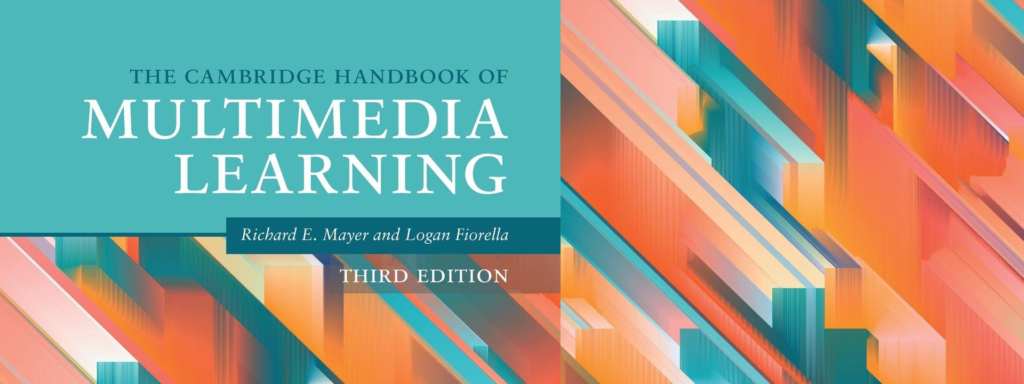Most learning designers are familiar with Richard Mayer’s Twelve Principles of Multimedia Learning but his Cognitive Theory of Multimedia Learning is not as well known.
That theory not only describes how the cognitive system processes multimedia content to produce learning but also highlights the limitations of the cognitive system. And Mayer’s theory is “based on empirical research evidence and on consensus theoretical principles in cognitive science.” (Mayer, 2021, p. 58)
Mayer’s cognitive theory underpins his twelve principles and informs us about what each principle is trying to achieve or avoid in order to maximize learning.
In this post, I’ll list the key concepts of Mayer’s theory with supporting notes but I won’t go into the mechanics of how multimedia content is processed. Instead, I highly recommend Mayer’s chapter on the theory from The Cambridge Handbook of Multimedia Learning (2021). The reference is at the bottom of this post.
Dual channel assumption
- “humans possess separate information processing channels for visually/spatially represented material and auditorily/verbally represented material. The dual-channel assumption is incorporated into the cognitive theory of multimedia learning by proposing that the human information processing system contains an auditory/verbal channel and a visual/pictorial channel.” (Mayer, 2021, p. 59)
Limited capacity assumption
- “humans are limited in the amount of information that can be processed in each channel at one time.” (Mayer, 2021, p. 60)
- “When an illustration or animation [or video] is presented, the learner can hold only a few images [or frames] in the visual channel of working memory at any one time, reflecting portions of the presented material rather than an exact copy of the presented material.” (Mayer, 2021, p. 60)
- “When a narration is presented, the learner can hold only a few words in the verbal channel of working memory at any one time, reflecting portions of the presented text rather than a verbatim recording.” (Mayer, 2021, p. 60)
Active Processing Assumption
- “humans actively engage in cognitive processing to construct a coherent mental representation of their experiences. These active cognitive processes include paying attention to relevant incoming information, organizing incoming information into a coherent cognitive structure, and integrating incoming information with other knowledge. In short, humans are active processors who seek to make sense of multimedia presentations.” (Mayer, 2021, p. 61)
Types of memory
- Sensory memory “allows for pictures and printed text to be held as exact visual images for a very brief time period in a visual sensory memory and for spoken words and other sounds to be held as exact auditory images for a very brief time period in an auditory sensory memory.” (Mayer, 2021, pp. 62)
- Working memory is “where central work of multimedia learning takes place.” (Mayer, 2021, pp. 62)
- “Working memory is used for temporally holding and manipulating knowledge in active consciousness.” (Mayer, 2021, pp. 62)
- Long term memory “corresponds to the learner’s storehouse of knowledge. Unlike working memory, long-term memory can hold large amounts of knowledge over long periods of time, but to actively think about material in long-term memory it must be brought into working memory.” (Mayer, 2021, pp. 63)
Demands on Cognitive Capacity
- Extraneous processing “refers to cognitive processing that does not support the instructional goal, and is caused by poor instructional design. Extraneous processing does not result in any useful knowledge being constructed in the learner’s working memory.” (Mayer, 2021, p. 66)
- Essential processing “refers to cognitive processing aimed at mentally representing the presented material in working memory, and is caused by the complexity of the material. Thus, essential processing results in the construction of verbal and pictorial representations in working memory that correspond to the presented material.” (Mayer, 2021, p. 66)
- Generative processing “refers to cognitive processing aimed at making sense of the presented material, and is caused by the learner’s motivation to learn. Generative processing involves reorganizing the incoming information and integrating it with relevant prior knowledge. Thus, generative processing results in the construction of an integrated mental model.” (Mayer, 2021, p. 66)
- “Learners differ in terms of their working memory capacity (or cognitive capacity) which affects their ability to handle each of the three kinds of demands on cognitive capacity. Learners differ in their cognitive and metacognitive strategies for how to engage in generative processing and essential processing. They differ in terms of their prior knowledge, that can help them handle the extraneous processing caused by poorly designed instructional situations or guide their essential and generative processing of familiar material.” (Mayer, 2021, p. 67)
- “Thus, the identical multimedia lesson may be overloading for one learner and not be overloading for another because of differences in the capacities, knowledge, skills, and belief (e.g., beliefs about how learning works) that learners bring to the learning situation.” (Mayer, 2021, p. 67)
- “The learner has a limited amount of cognitive capacity to process information in each channel in working memory during learning, so capacity that is used for extraneous processing cannot be used for essential and generative processing. In short, the sum of extraneous processing plus essential processing plus generative processing cannot exceed the learner’s cognitive capacity. Given that the learner’s cognitive capacity is limited and the three demands on cognitive capacity are additive, if the learner increases one kind of processing then another one must be decreased.” (Mayer, 2021, p. 67)
